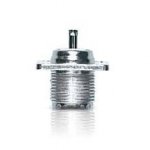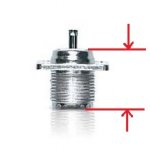Probably similar to this:
Just WOW!!! My word searching is REALLY BAD???!!! Just out of curiosity, PLEASE tell me what you typed???
I was typing, "how do they make a 2m antenna so short" and all different other ways of wording that... like aLOT of different ways and I kept getting the same similar "hits/results".
^^^THAT... what you posted^^^ is what I was looking for!!! Thank you for that.
Trying to play with a portable antenna for getting it on the frequency you want can be trying. The best and simple way is to get the info on the antenna you have and look for the cutting chart the company that supplied it.
Normally there is a helical coiled length above the base that looks like a very small door spring to close a door that is incased in the rubber type coating. The cutting chart will indicate how long the long top section of the whip should be for the frequency range your trying to use.
You could consider a mobile radio and a mag mount to put on the roof. It isn't that hard to install one. If your into learning about radios, you might consider an old radio like a Motorola Spectra. They come in different bands line low band, VHF and UHF. It is not that hard to put them on the ham frequencies. Plus there is plenty of info on the Internet about them. The down side is you need a computer with a clock speed around 1GHz or lower to be able to run DOS operating system on it. Then it will take a RIB (Radio Interface Box) to go from the serial port on the computer to the RIB.
You can make your own cables to go from the computer and the RIB. Then make your own cable to go from the RIB to the radio. This same cable will fit all the Spectra mobiles except the front dash mount radio. This takes a different cable from the RIB to the radio.
The web site called Batlabs contains all the cabling information you will need.
If your more comfortable with a commercial radio, then go out and buy one. There are a good number of them on the market that are sold by many companies.
You can use a mobile in your home, but it will take an AC power supply to provide the need current to match what the transmitter requires with a little to spare. A simple dipole antenna will get you started.
There are some very knowledgeable people on the board here. So if you have Questions, just ask away and someone will come back and provide some help.
You might get on the Internet and do a search to see if there is a ham club near you. Go to some of the meetings and get to know the people there. You might even find someone to take you under their wing and be a mentor for you.
Jim
Believe it or not, I used to do SOME programming Moto radios and even started programming Harris radios, which, sorry, I do NOT care for Harris radios... well, the radios are actually pretty damn nice, but MAN, pinout, their radio name/models can be a bit confusing at times, etc.
Anyways, I mainly dealt with CDM 750, 1250, etc. I used to work along side first responders and alerting systems. BUT, with all that, I've never had to "build" antennas and such. That is a SUPER LONG STORY in itself, but just know that. I had to build custom pinout cables for XTL's, CDM, Spectra, and the list goes on. I know about Call Alert, DTMF, Two-Tone Sequential, Tone Remote (although it is getting a bit fuzzy now remembering how the low guard tone and high guard tone work... but anyways, building an antenna is very new to me and seems interesting. I have a tech class license, but haven't really been on air for quite some time... family as well as other things that were going on the past few years.
Thank you for that information either way!!!
Anyways, trying to pick up where I left off going on about 3yrs now.
Literally, right now, just today, I bought some parts to start making my own 2m vertical. Simple, I know, but I'm trying to learn and I even have an idea that I THINK might work, but I'll wait to build it, test it, and then hopefully take pictures and post it. I've NEVER heard it being done for a 2m vertical or, at the very least, have seen anyone mentioning/posting the idea I have in mind... anyways, I want to do it first and then show you guys...
Anyways, thank you SO MUCH people. I'm doing my best the fastest that I can and trying to learn on my own as much as possible. I just may need help here and there, but I do NOT mind reading on my own and doing my own research. As you can see, my "research wording is just bad"... HAHAHAHAHAHAHA, what can I say???
Btw, I STILL have an XT that I built quite a few years back running DOS v3.30 with a 25MB Seagate on a RLL/MFM controller.



